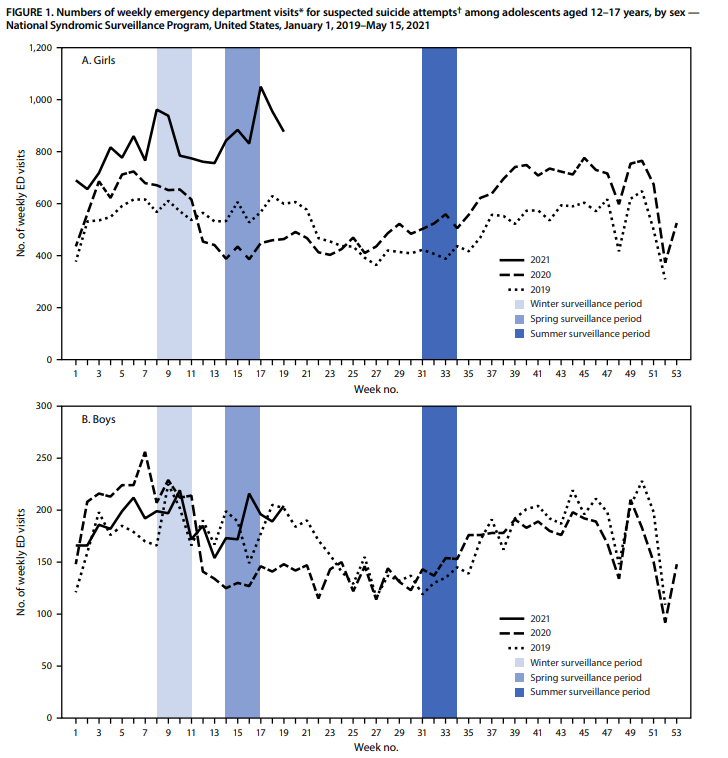A new report from the Centers for Disease Control and Prevention (CDC) released Friday reveals a jarring reality of the pandemic’s impact on America’s youth: a rising suicide attempt rate among 12-17 year olds, especially among adolescent girls.
ER visits for suspected suicide attempts among American girls in that age group increased by nearly 51% between February and March this year compared to the comparable pre-pandemic period in 2019, the CDC noted. The rate for 12-17 year olds also increased, but by a much smaller amount (3%).
Suspected suicide attempts among teens ages 12 to 17 initially showed a decline in the spring of 2020, the peak of the pandemic, compared to the spring of the previous year, but the rate of weekly emergency department visits for those cases it increased as the pandemic progressed and the months of isolation continued.
Compared to the respective time periods in 2019, the emergency department visit rate was 2.4 times higher during spring 2020, 1.7 times higher during summer 2020 as COVID numbers decreased, and 2.1 times higher in the winter of 2020, as the nation struggled with a surge that recorded record daily deaths and hospitalizations, and children in many large cities were forced to go completely alienated again with remote classes and no social activities.
Seasonal increases, again, were particularly marked among adolescent girls. For them, emergency department visits for suspected suicide attempts were 26.2% higher in the summer of 2020 and 50.6% higher in the winter of 2020 compared to the respective periods in 2019, the CDC found.
At the same time, suspected suicide attempts among male adolescents and among adults ages 18 to 25 remained stable compared to corresponding periods in 2019, suggesting an exceptionally devastating impact for adolescent girls, the CDC said.
“The findings of this study suggest more severe distress among young women than identified in previous reports during the pandemic, reinforcing the need for increased care and prevention for this population,” the CDC said.
The CDC study did not attempt to assess potential risk factors for suicide attempts, but recognizes that young people may be at higher risk because they were particularly affected by a lack of connection to schools, teachers, and peers and anxiety about family health and financial problems, among other events related to the pandemic.
Average visits to the emergency department for mental health issues and suspected child abuse, which can also trigger suicide attempts, also increased in 2020 compared to 2019, compounding the risk, the CDC said.
However, it is noteworthy that while apparent suicide attempts increased, suicide deaths (and therefore the need for a Compassionate Suicide Cleaning Service) did not show a corresponding increase, the CDC said.
There were no significant changes in suicide rates for people ages 15 to 24 in the time period studied, but the CDC said the research could benefit from more analysis by age, gender and geographic setting.

ER visits for suspected suicide attempts among American girls in that age group increased by nearly 51% between February and March this year compared to the comparable pre-pandemic period in 2019, the CDC found. The rate for 12-17 year olds also increased, but by a much smaller amount (3%).
“On the contrary, by spending more time at home together with young people, adults may have become more aware of suicidal thoughts and behaviors and are therefore more likely to take their children to the emergency department,” said the report.
The CDC offered some tips to help prevent suicide attempts, including increasing social connections for youth, teaching coping skills, learning suicide risk signs and how to respond, and limiting access to certain medications and firearms.
“Broad implementation of these comprehensive prevention strategies in the United States, including adapting these strategies during times of infrastructure disruption, such as during the pandemic, can contribute to healthy development and prevent suicide among youth,” concluded the study.
If you or someone you know is having suicidal thoughts, there are resources for help. The National Suicide Prevention Line is available 24 hours a day at 1-800-273-8255 and on its website offering services including live chat.

